Timothy Riesterer's Blog, page 7
February 14, 2020
Everything You Need to Know About Whiteboarding in Sales
The post Everything You Need to Know About Whiteboarding in Sales by Tim Riesterer appeared first on Corporate Visions.

Whiteboarding your sales presentations is a powerful alternative to PowerPoint—and research shows it’s more effective, too.
You’ve likely heard the phrase, “Death by PowerPoint.” It’s
become a common way to describe the mind-numbing experience of sitting through
a feature-length slide presentation filled with bullet points and clip art.
It’s a little dark, but the point is clear: If you want to engage your audience, while standing out from your competitors, relying on a shoddy sales deck isn’t the answer.
Thankfully, there’s a better way to deliver your sales presentations—one
that won’t put your audience to sleep.
What Is Whiteboarding in Sales?
Whiteboarding is a modern selling methodology that
incorporates elements of visual storytelling to effectively engage your audience
during your sales presentation.
Unlike PowerPoint presentations, whiteboarding can empower your
sales team to convey your message with more consistency and confidence. Research
also shows that whiteboarding communicates a more memorable sales message than
traditional slide presentations.
Why Should Sales Reps Be Whiteboarding?
Whether you use a whiteboard, a flip chart, or the back of a
napkin, telling a compelling visual story can be a powerful differentiator in
competitive and complex selling environments.
With proper execution, whiteboarding has the ability to
shorten sales cycles and build greater trust with buyers.
In fact, our research shows that simple, concrete, hand-drawn visuals on a whiteboard outperform PowerPoint presentations in the areas of recall, engagement, presentation quality, credibility, and persuasion.
These benefits hold true in remote selling environments as well. A separate research study found that using interactive visual stories for virtual sales calls boosts engagement, increases favorable attitudes toward your story, improves recall, and makes prospects more likely to meet with you.
These studies reinforce what decision scientists call The Picture Superiority Effect—a research-backed concept affirming that pictures are far better than words at getting people to remember what you communicate. And making your message more memorable is critical, especially considering that memory is the catalyst for decision-making.
Keep in mind, however, that whiteboarding successfully takes
more than just drawing pictures or writing down words. Wielding a pen instead
of a clicker as your sales weapon of choice requires a purposeful, repeatable,
and structured approach.
How to Start Whiteboarding Your Sales Presentations
Incorporating visual storytelling into your sales strategy needs to be developed into a systematic process within your organization. Following these three steps will ensure that your sales reps can deftly deliver your story with confidence and conviction.
1. Develop Your Whiteboard Presentation
Great whiteboards look spontaneous, and the imagery seems
simple, but they’re the product of a well-facilitated
message development process. They follow a proven choreography for how a
great story is built, told, and visualized.
Whiteboarding should also include and leveraging brain science in the process. This includes understanding how visual contrast is required to spark a reaction to your picture, and how to grab and spike attention with compelling visual techniques and storytelling models. It isn’t merely about putting some words, arrows, and stick figures on a board.
If you can’t explain or justify why you draw your whiteboards the way you do, then you’re just guessing and hoping that it’s useful. Instead of guessing, develop your whiteboards using science-backed principles that are tested and proven to work. And ensure your message matches the specific decision you’re trying to address in the different stages of the customer journey.
2. Deploy Your Whiteboard Presentation
Packaging your whiteboard presentations for use in the field
requires a toolkit containing coaching and customer-facing content. As you
might expect, teaching a sales rep to deliver your whiteboard is like helping
an actor learn their part—it’s requires both a compelling message and a
convincing delivery.
As the director, you provide a script and a
storyboard. You will need to decompose your whiteboard into a “build,”
showing how each part is drawn, along with the commentary behind it. This is
documented in a sales coaching guide with thumbnail pictures of the whiteboard steps
with the accompanying script next to it.
You should also capture an example of someone delivering
your whiteboard presentation and providing a video or voiceover of a slide
deck, complete with illustrated images and micro-builds. This helps demonstrate
the ideal timing, cadence, emphasis, and interaction.
3. Deliver Your Whiteboard Presentation
Here’s where the rubber meets the road. Your sales reps need
to understand both the art and science of whiteboarding.
Your salespeople need training on the use of a pen and a
writing surface and getting comfortable with the whiteboard presentation. They
need to understand the why behind the story—why the story needs to be told the
way it’s been developed. Share the supporting psychology and storytelling
models at work in the content, as well as the ultimate objective for each
whiteboard.
Practice, practice, practice. Repeated three
times not to be trite, but because this is the part where many whiteboards fall
apart.
Your salespeople need to practice delivering the whiteboard until they can deliver it naturally and demonstrate complete command of the content. It’s not just about eliminating errors. Ongoing training, practice, and coaching builds confidence and creates ownership around the story. Ideally, you will develop coaches who are capable of providing appropriate feedback and certify client-facing folks on their delivery.
Whiteboarding Examples
Here are some examples of whiteboarding in action. The following slide deck includes three example whiteboards:
The Dangers of One-Size-Fits-All Sales Messaging from Corporate Visions
1. Slides 2-6 – The first whiteboarding example explains why customer expansion requires a different approach than customer acquisition.
2. Slides 10-18 – The second whiteboarding example illustrates
the power of Unconsidered Needs in your acquisition-focused sales message.
3. Slides 23-30 – The final whiteboarding example shows
the benefits of using research-backed renewal
and expansion message frameworks.
Of course, these three visual examples are only one dimension
of the full whiteboard presentation. How you deliver the story verbally adds depth
and weight to your story.
Check out the recorded video of this presentation to see these whiteboard examples in action.
Whiteboarding For Better Sales Presentations
Great visual stories don’t happen spontaneously. You need to
intentionally plan and build them based on the different buying moments in the Customer
Deciding Journey.
In the beginning, you need to answer the question in the prospect’s mind: Why should I change? You need a whiteboard that helps them see why their status quo isn’t safe. It should also convey why they need to consider doing something different.
The next question is: Why you? For that, you need a visual
story that clearly delineates your differences and strengths in contrast to the
status quo and the competitive alternatives.
Finally, you need to answer the question: Why now? That
calls for a visual story that presents the business case and a relevant example
of how someone achieved their desired outcomes and realized the projected
value.
Each of these requires a different, complimentary
whiteboarding practice that builds on the previous one. They develop your story
along the path to decision-making solution that results in a sale.
Having a good sales process is important. But having
something truly provocative to say when you actually interact is essential.
Visual storytelling is the fuel that powers your sales process engine.
Read our collection of research-backed selling techniques to discover even more ways to improve your team’s performance.
Thank you for reading this post from Corporate Visions - Differentiate Your Marketing Messages and Sales Conversations.
February 4, 2020
Selling to the C-Suite: How to Get Executive Decision Makers to Act Now
The post Selling to the C-Suite: How to Get Executive Decision Makers to Act Now by Jim Druckrey appeared first on Corporate Visions.
[image error]
Confidence and competence. All too often, that’s what salespeople lack when selling to the C-suite and other financial decision makers.
In fact, Corporate Visions research found that the majority of companies aren’t satisfied with their ability to tell an executive-level story.
67 percent say they’re underperforming at
getting executive-level prospects to buy now rather than laterOnly 39 percent are confident in their
ability to build a meaningful business and financial case to justify a decision
These are big issues, considering that 80 percent of your
deals will require a VP or higher-level signoff. Without executive buy-in, your deals stall, you lose momentum,
and your close rates plummet.
But dig a little deeper, and you see that stalled proposals
and lost deals are the symptoms of a value communication problem. Sales
reps lack the competence and the confidence to elevate the conversation, create
enough urgency, and show enough business impact to persuade executive buyers to
make a decision now.
So, how can you overcome this “fear of heights” when you’re selling to the C-suite?
Elevating Your Sales Conversations for the C-Suite
When you’re sitting across from a CXO, you only get one shot
to pique their interest. If you don’t come to the table with enough knowledge
and insight, they’ll shut you down without a second thought, and you won’t get
another opportunity.
Demonstrating competence does not mean competence in
your own business. It means being perceived as competent in your prospect’s
business. Enterprise sellers get delegated to who they sound like. So if you
want to win over C-suite buyers, you need to show competence in their business,
at their level.
To make it happen, you need to take the Buyer’s Perspective
and achieve what I like to call, “I know that you know that I know.”
In other words, the executive decision maker needs to understand that your head is inside their business—not the product or service you want to sell them.
Here’s how you do it.
A Proven Formula for Selling to the C-Suite
[image error]
1. Highlight External Factors
External Factors are out of the control of your C-level
decision maker. They might be regulatory changes, tariffs, interest rates,
geopolitics, oil prices, technology changes, and so on. It’s literally what
keeps executives awake at night (but please, don’t ever ask any executive that
question).
External Factors are critical because it’s where you can create the most value—it’s where both the problem and the solution are unknown. So, start each of your executive conversations with a few External Factors that are out of their control, to establish your credibility in the first couple minutes of the sales conversation.
2. Identify Business Initiatives
Your prospect’s business initiatives, or “strategic
initiatives”, are often shaped by External Factors. These are essentially the
major drivers of the company. Are they trying to increase share, grow revenue, cross-sell/upsell,
expand into new markets, grow through mergers and acquisitions? You need to
identify what their strategic initiatives might be.
Check out this 20-minute cheat sheet for making your executive conversations more insightful.
3. Introduce Unconsidered Needs
Executives are always looking for an edge. Telling an executive something they already know doesn’t create that edge or bring any value. By introducing Unconsidered Needs, you’re amplifying a missed opportunity or a problem they’ve underappreciated or didn’t even know about. That’s how you create urgency and differentiate yourself.
What is an Unconsidered Need? Think of it this way: You’re telling your C-level decision maker something they didn’t already know about an opportunity, problem, or risk they didn’t know they had.
Sometimes you can’t challenge the executive’s strategy, but you can challenge their certainty by introducing a risk. And risk is one of the few subjects that doesn’t get delegated down. When you bring in a risk, you light up the executive’s brain to think more carefully about what they don’t already know.
4. Provide a Solution Story
You’ve shown that you understand the External Factors that
shape and create your buyer’s strategic business initiatives. But what is the
future state? How can you help them resolve the Unconsidered Needs you
identified and get to that future state? The connection between their current
state and their future state is your Solution Story.
The Solution Story is what creates a Buying Vision—the
vision of where you want to lead your buyer. And you’ll likely need to use
financial metrics in the process. Executives need financial proof to underpin
that Buying Vision.
5. Quantify the Business Impact
Decisions, even at an executive level, are made
subconsciously in less than the blink of an eye. Then the rational, analytical
part of the brain takes over to justify the decision. That’s the part that
responds to logical information like ROI.
Quantitative results and ROI don’t drive executive decisions, but they are useful as a tool to for the decision maker to explain their decision to others, and to justify it to themselves in the process, priming them for action.
The ROI calculation you use should be specific for your
customer. It might be return on sales. It could be return on capital. You just
need to do a little research. Look at their annual report, read an earnings
call transcript, and understand how the C-suite is being measured.
Conclusion
When selling to the C-suite, you need to elevate your conversation and teach them something they don’t already know about their business.
Create a compelling Buying Vision, illustrate how your solution can resolve their previously Unconsidered Needs, and how you can ultimately help them realize their strategic goals.
Watch my recent webinar, Toe to to with the CXO, to discover even more sales strategies and CXO insights for improving how you sell to C-level executives.
Thank you for reading this post from Corporate Visions - Differentiate Your Marketing Messages and Sales Conversations.
January 23, 2020
Avoid These Critical Mistakes in Your Quarterly Business Reviews
The post Avoid These Critical Mistakes in Your Quarterly Business Reviews by Nicci Nesmith Hammerel appeared first on Corporate Visions.

Is your quarterly business review format putting your customer relationships at risk?
Once your prospect becomes a customer, you might focus on
typical customer success drivers, like getting your customer to adopt and love
your product, or to stay engaged through check-ins and quarterly business
reviews.
After all, these efforts result in a happy customer, and a
happy customer will continue to be a customer, right?
But while you’re having a quarterly business review with
your customer about utilization metrics and project status updates, that same customer’s
name is moving through your competitor’s sales funnel—being targeted with
marketing campaigns, discussed in sales forecasts, and being put through
account strategy planning sheets.
Your competitors will never stop trying to dislodge your
customer relationship. And they’re right to never give up. Whoever brings an
industry or business problem to your customer’s attention first, wins.
If you’ve ever had a customer reduce their spend with you or go elsewhere for a solution they could have bought through an upsell with you, that’s why. Your competition wasn’t particularly clever. Your customer wasn’t disloyal. You simply didn’t take the steps you needed to strengthen and fortify the relationship.
You left the relationship exposed for someone else to swoop
in, bring your customer insight, and take what should have been yours.
So, why does it happen? And how can you prevent it from
happening to your customer relationships?
It starts by avoiding these two critical mistakes during
your quarterly business review conversations.
Quarterly Business Review Mistakes to Avoid
1. Focusing on the wrong metrics.
In conference rooms all over the globe, business reviews are being conducted right now, outlining how much the customer is utilizing your product, how many hours you’ve billed from their services contract, how many features users have adopted, how well service disruptions have been resolved, and the like.
These metrics prove your busyness. They feel good to talk
about. But they aren’t results.
They are leading indicators for larger revenue, expense,
cash, or balance sheet goals. Your customer approved the expense of working
with you because they believed you would make a meaningful contribution toward
their business goals. But Account Management and Customer Success teams often
don’t measure or report on business outcomes, nor do they connect the dots
between leading indicators and a customer’s corporate goals.
Sometimes that’s simply a reflection of what your contacts
want to talk about. But if the team you’re meeting with for quarterly business
reviews doesn’t care about or know their business’ goals, you can be sure that
you’re not talking to the ultimate decision makers. And that means your
relationship is totally vulnerable to competitors who are.
2. Insulating your customer from outside pressures.
Many Customer Success teams keep their conversations
singularly focused on the problem customers initially needed to solve.
Perhaps you don’t want to rock the boat or sound like you’re
constantly trying to upsell. But it’s a huge mistake to assume that your
customer doesn’t want to hear about shifting industry pressures that will put
their goals at risk. This opens the door wide for your competitors to walk in.
When you’re presenting these outside pressures, be careful not to present them as earth shattering, disruptive changes—that can invite a competitive evaluation. Instead, make your customer smarter about what’s slowly shifting around them. Do it in a way that puts salve on the part of their brain that fears change.
You need to make your customer feel safe and assured that they’re already working with the partner who can help them solve pressures as they arise.
Even if your customer isn’t ready to act on the pressures
you expose now, you were the one who brought them to light—not your
competitor—so you get the credit. That strengthens the protective barrier
around your relationship.
When your customer feels the urgency around the issues
you’ve surfaced, they will know who they can count on to resolve them. They won’t
need to look elsewhere.
Build a Protective Barrier
In your quarterly business reviews, creating happy customers can’t be your primary goal. The only real measure of a successful relationship is that your customer chooses to buy from you again. That’s it.
To make that happen, you need to prove you’re helping your customer make progress toward meaningful business goals and you’re ahead of evolving pressures that might put those goals at risk. When you communicate those things in every interaction with your customers, you create a barrier around your relationship that blocks encroaching competitors and increases the likelihood your customer will continue to buy from you.
Check out our e-book, Four Must-Win Commercial Moments in Customer Success, to discover research-backed messaging frameworks for winning more revenue from your existing customers.
Thank you for reading this post from Corporate Visions - Differentiate Your Marketing Messages and Sales Conversations.
January 15, 2020
How to Make Sure Your Buyers Remember Your Message
The post How to Make Sure Your Buyers Remember Your Message by Carmen Simon appeared first on Corporate Visions.

The Science of Memorable Content
If you’re in Sales or Marketing, you’re in the business of influencing other peoples’ choices.
Every time you communicate with your buyers, it’s an
opportunity to move them in some way—to change, to choose you, or to stay with
you instead of switching to a competitor.
There’s just one big obstacle in your way: Most people will
forget up to 90 percent of what you communicate. And they’ll forget it rather
quickly.
People act on what they remember, not what they forget. So,
if you want to persuade your buyers to act in your favor, you should make sure
your message sticks in their minds.
You need to become part of their memory.
The latest scientific research places memory at the heart of decision-making. Studies show that in the process of making a decision, your brain predicts the rewards of a choice based on past memories, and then uses that information to make the most favorable decision.
Think about that. The brain is a prediction engine. And memory
is the fuel that helps it make better decisions. Memory doesn’t just keep track
of the past; it helps you navigate the future.
The Prospective Memory Model
Your buyer’s decision to purchase will happen in the future,
but you can influence those decisions in your favor now.
Prospective Memory means “remembering a future intention,”
and using this model has remarkable advantages for every seller and marketer.
Imagine this for a moment: You create content at Point A, hoping your audience remembers and acts on it at Point B. The skilled presenter knows how to communicate information at Point A, so it creates a future intention at Point B and motivates their audience’s decisions based on that intention.
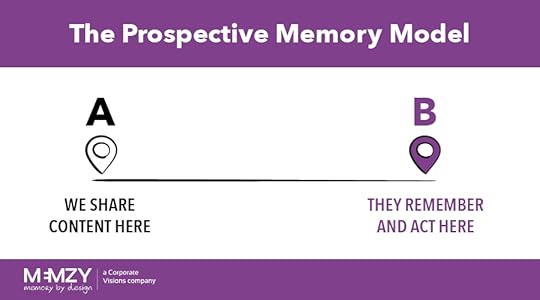
Influencing Future Buying Decisions
Getting your buyers to act on what they remember always
starts with an intention they either already have or one you want to plant in
their minds.
Research says that people act on future intentions when they
complete these three steps:
Notice Cues that are linked to their
intentionsSearch their memory for something related
to those Cues and intentionsAnd execute on their intentions if
something is rewarding enough
With this Prospective Memory Model in mind at Point A, you
can prime your audience with the proper Cues, help them keep what’s important
in their long-term memory, and make it easier for them to execute on intentions
at Point B.
Most business content leaves the process of Prospective Memory completely to chance. As a result, your audience forgets a lot, and the little they randomly remember doesn’t always lead to action.
So, how can you create more effective and more memorable content?
Three Steps to Influence Memory and Decisions
When you ask your buyers at Point A to act on a future
intention, they strike a tacit deal with you. They implicitly say, “I will stay
with you to Point B as long as you keep me rewarded.”
No rewards, no action.
Your buyers will look for rewards at all three stages of the
decision process: when they notice Cues, when they search their memory for
connections between their intentions and those Cues, and when they decide to
execute. Here’s how you can influence these three steps:
1. Create Cues
People always intend to do something next. Cues are signals
or triggers that something must be done at a specific time, or during a specific
event.
For Cues to work, they must be both distinctive enough and
tied to an intention people care about.
2. Bridge Cues and Intention
After noticing a Cue, your buyer will search for a memory
related to that Cue and their intentions to act.
If the Cue and intention are sufficiently linked in your
content, and if they notice the Cue when it counts, your buyer will act on
their intention.
3. Motivate Decisive Action
People will only act on their intentions if the result is
rewarding enough. But memory doesn’t influence action on its own—emotion and
motivation also play a part.
Together, the three processes predict, measure, and recall
the rewarding (or punishing) outcomes of a choice. Are you making it clear how
your content enables others to move toward something rewarding?
Make Your Content Impossible to Ignore
Using the Prospective Memory Model when creating sales and marketing content, your goal is to become part of your buyer’s future.
You create content and share it at Point A, connect it to
your buyer’s intention, and encourage them to remember to act on it at Point B.
Using this approach, you can intentionally place memories in people’s minds and
use Cues to guide them toward future action.
Memory works on the basis of associations—one thing can
trigger another. What Cues exist in your buyers’ world that can trigger
memories of you? How will you influence what you want them to remember, instead
of leaving the process to chance?
The brain is searching constantly for the next and biggest
reward. In the process, it balances ease and exploration. It goes back to
low-effort habits that have proved rewarding in the past. And it seeks to learn
new information that brings better rewards.
Are you going to be part of your buyer’s next reward? When you develop highly memorable content that hooks into rewards from the past but also provides new sources of rewards, you become impossible to ignore.
Get our new e-book, Impossible to Ignore: The Science of Unforgettable Content, to learn how you can build highly memorable content that drives future decisions.
Thank you for reading this post from Corporate Visions - Differentiate Your Marketing Messages and Sales Conversations.
January 9, 2020
Why Your Sales Kickoff Needs a Shake-Up
The post Why Your Sales Kickoff Needs a Shake-Up by Tim Riesterer appeared first on Corporate Visions.
[image error]
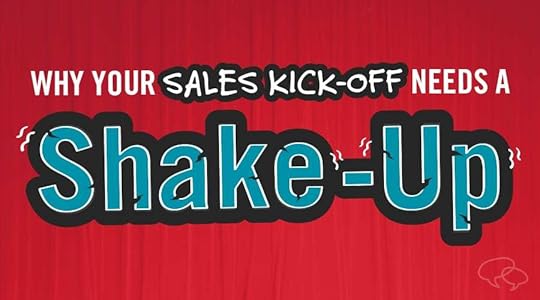
The goal of every great sales kickoff event is to get your team fired up, energized, and ready to win.
Yet, year after year, most sales kickoffs get dragged down by too many informational, product-based breakouts. And all these product presentations often come at the expense of more customer-centric activities—including practice and coaching—that actually drive more energy, better performance, and lasting behavior change.
It’s time to give your sales kickoff a much-needed shake-up.
Successful sales kickoffs don’t get hung up on product enablement. Instead, they focus on better customer conversation enablement—the story and skills your sales teams need to move the buyer from status quo to interested to yes!
Planning the Perfect Event: Your Sales Kickoff Agenda
To plan the perfect sales kickoff, you need a solid agenda.
Your kickoff should start by helping sellers understand what
excites buyers (based on research, not so-called “best practices”). From there,
introduce new stories that match the science behind how buyers frame value and
make choices. Then, pivot to the new storytelling skills required to deliver those
distinctive customer conversations.
What’s with all the science? If your sales team’s goal is to build more pipeline, close more deals, and make those deals more profitable, what could be more motivating and meaningful than giving your reps research-backed selling techniques that are proven to help them achieve those goals?
When you add in observable practice and tailored coaching—along with follow-on activities for demonstrated proficiency—you’ll continue to see positive results in the field, long after your kickoff concludes.
Looking for a theme for your meeting? Check out these science-backed sales kickoff themes .
Here are nine steps to planning your sales kickoff agenda, before, during, and after the event.
1. Create scenario-based stories
Identify what unique selling scenarios your sales team will face in the coming year, based on your go-to-market, product, and growth strategies.
Create the right selling story for each of those scenarios based on the psychology of the buyer across the Customer Deciding Journey (not your sales process). Apply tested, proven messaging frameworks to the different decisions your prospect or customer is making.
2. Build the content
Develop an interactive, integrated playbook for each of the new scenario-based messaging plays, containing your message and content assets, as well as short “how-to” and skills coaching videos.
Don’t rely on one-size-fits-all messaging. Your reps need to
know what works best for every type of conversation they have with buyers. Each
playbook should be designed to enable your sales reps for each of these distinct
conversations.
3. Prepare your sales leaders
Get key sales leaders (both managers and top performers) fluent in the story. They should be able to champion it internally and deliver it with confidence, energy, and impact. These leaders should be equipped and prepared to coach the story at the event.
To prepare well, your sales leaders and table coaches need
to practice the stories ahead of time. Prepare storyboards and talk tracks as
guides, so they understand the key features of your story. Build coaching guides
that reinforce the key points of differentiation and emphasis in the stories.
4. Strike the right keynote
A keynote sets the tone for the rest of the sales kickoff event. It inspires your sellers see why they need to change and motivates them to actually make the change happen. A keynote has to get them excited about improving their performance, while creating demand for the rest of their experience at the event.
For your new scenario-based messaging, content, and skills,
your keynote must make the case for a new way of engaging prospects and
customers. Reveal how your sellers’ good intentions come up short because
they’re based on wrong instincts. Present the underlying decision-making
science, showing clear contrast between the new and old approaches.
5. Demonstrate great delivery
It’s critical for your sellers to observe your new stories delivered flawlessly in front of their eyes. This shifts the focus from theory to practical application by bringing the new story and skills to life.
Make sure to debrief the audience after the delivery to
shine light on the pivotal moments of the story. Underscore a) how it’s
different; b) how it leverages the science; and c) how a new story told well
can be the difference, even in markets where there’s little difference between
the offerings themselves.
6. Practice the message
Now, it’s your sellers’ turn. They must try on and take ownership of the new message and new skills and deliver that story themselves.
This takes place in breakouts, where each rep takes turns
practicing, standing, delivering and receiving initial coaching and feedback at
a table of 6-8 peers. After each session, every rep will have had a chance to
hear themselves delivering the story and watch several of their peers do the
same thing.
7. Certify the message
The key to behavior change is making sure there’s a demonstrated level of proficiency on the story and the skills needed to tell that story.
After your kickoff, give each of your sales reps a challenge
to record themselves delivering the message. Have them upload the recording to
a system where subject matter experts can assess them using a rubric designed
to define and certify fluency.
8. Activate manager coaching
An underestimated but powerful outcome from the video recording challenge and certification process is that managers can see exactly where their reps need coaching help.
Getting managers involved is essential for ongoing skills
development, application, and reinforcement in the field. This approach gives
them specific examples to coach from as opposed to a blank sheet.
9. Apply must-win deal coaching
One way to guarantee measurable application of your new messaging and skills is through deal coaching. With deal coaching, you can drive adoption and track impact on the most visible, must-win opportunities for your company.
Imagine each rep being required to pick one of their biggest
acquisition and/or renewal opportunities. Using your new scenario-based
messaging, they work with subject matter experts to craft a tailored
presentation for that must-win opportunity. Then, they practice the presentation
using all the new concepts and skills they’ve learned at your kickoff event.
Make Your Next Sales Kickoff the Best Yet
It’s time to make your sales kickoff what it was always
meant to be—the ideal venue to spark lasting business transformation.
To make it happen, you need to stage a kickoff event that
gets your sales team revved up and prepared to succeed right out of the gates.
They should walk away motivated and wanting more—more messaging, more content,
more skills, and more coaching; just like they got at your kickoff.
Want more tips to make your sales kickoff a success? Check out our e-books, Why Your Sales Kickoff Needs a Shake-Up and Putting Your Sales Kick-off In Context.
Thank you for reading this post from Corporate Visions - Differentiate Your Marketing Messages and Sales Conversations.
December 12, 2019
Four Imperatives for Sales Enablement in 2020 and Beyond
The post Four Imperatives for Sales Enablement in 2020 and Beyond by Erik Peterson appeared first on Corporate Visions.
These four Sales Enablement trends present a glimpse into the future of your organization.
[image error]
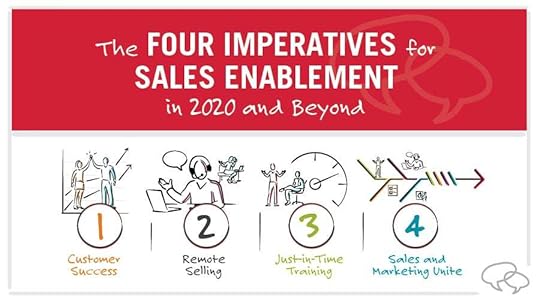
Sales Enablement has the opportunity to evolve in a big way.
When Sales Enablement first showed up in the B2B enterprise, the role became a sidekick to the in-person, acquisition-focused selling conversation.
But selling today looks completely different than it did back then. And given the role’s unique position, Sales Enablement is primed to step up, take the lead, and drive a new approach to sales and marketing messaging, skills, and content for years to come.
These four emerging and imperative trends will drive Sales Enablement in 2020 (and beyond).
Four Sales Enablement Trends for 2020
1. Customer Success Emerges as a Growth Engine
Analysts estimate that 70-80 percent of the average company’s annual revenue now comes from existing customers. And our research shows that if you use the same selling strategy, message, and skills to sell to an existing customer that you use when you acquire a new logo, you decrease the likelihood of retaining or expanding with that customer.
To adapt, Sales organizations need to become situationally fluent, recognizing the difference between acquisition and expansion, and Customer Success needs to get better at selling value to existing customers.
2. Remote Selling Replaces Face to Face
75 percent of all sales calls are now conducted over the phone or the web, yet most Sales Enablement strategies are built for face-to-face selling scenarios. As a result, sellers are radically under-enabled for the most common selling scenario.
Remote selling is a different animal—one that requires a completely different approach to Sales Enablement. In 2020, you need to enable the remote selling conversation first. And only after you’ve done that should you enable the in-person conversation.
3. Training Adapts to the Speed of Business
Sales Enablement has generally been effective when looking
at the company’s revenue budget for the coming year, building a twelve-month
program against that budget, and executing that plan. Unfortunately,
twelve-month plans are rarely relevant past month three.
Businesses are so dynamic and new challenges come up so quickly
that traditional training models just can’t keep up. When unplanned business
needs arise, you need to launch dynamic training that equips your team with the
skills they need to respond immediately. To deliver training at the speed of
business, organizations need to identify needs and roll out the appropriate
solutions in weeks, not months.
4. Sales and Marketing Converge
The B2B buying process isn’t as linear or predictable as Sales
leaders assume. In fact, it’s more convoluted than ever, handoffs are less
defined, and buyers are struggling to make sense of their options. The
companies that win will be the ones in which Sales and Marketing work together
to help people make buying decisions. Sales Enablement is the natural bridge
between these two sides.
One way to make your customer’s buying decision easier is to provide tools that help them take the next step in their buying journey. These tools should be simple, relevant, and credible. They should be built to enable consensus, since most buying groups are now made up of six to 10 people. And the best way to build those tools is to understand how customers make decisions.
Sales
Enablement Can Take the Lead
As a Sales Enablement leader, you can
choose to seize these trends and lead the charge toward the new reality of
selling. Or, you can hold back, waiting to be told to address these issues to
catch up with your competition.
Whatever choice you make, these trends presents a glimpse
into your future.
Get our latest e-book, The 4 Imperatives for Sales Enablement in 2020 and Beyond, and take this opportunity to show your organization that you have a plan to address these trends before your competition.
Thank you for reading this post from Corporate Visions - Differentiate Your Marketing Messages and Sales Conversations.
November 21, 2019
Sales Strategy: What’s Most Effective? A Great Message!
The post Sales Strategy: What’s Most Effective? A Great Message! by Tim Riesterer appeared first on Corporate Visions.
[image error]
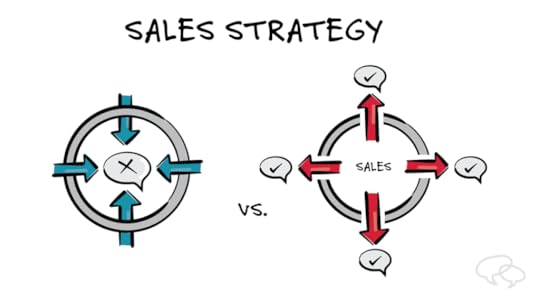
How do you create the best and most effective sales strategy? Most advice out there tells you that as long as you have a documented plan, a solid process, and a bullpen full of reps who know your solution inside and out, you’re ready.
Well, not quite.
The problem is, most sales
strategies are too internally focused. They succeed in documenting internal
procedures but lose sight of the messages and skills your reps need to communicate
value to your customers.
Consider the following insights:
Research performed by SiriusDecisions shows
that the number-one inhibitor to Sales achieving quota is an “inability
to communicate a value message.”In corresponding research in which SiriusDecisions
asked executive customers about the quality of interactions with
salespeople, only 10 percent said sales calls provide enough value
to warrant the time they spent on them.A Forrester Research study revealed that only
15 percent of sales calls add enough value, according to
executives surveyed.The Forrester study also showed that just seven
percent of surveyed executives say they would probably schedule a
follow-up.
In other words, if your sales
force can’t communicate value—why your solution is different, better, and worth
more—your sales strategy won’t help you get more sales.
So, what can you do?
In this article, you’ll learn 10
tips for building a sales strategy that actually works. Each one is backed by
research and has been rigorously tested and proven to be effective in B2B
selling situations.
But first, it’s important to
step back and clarify what it really means to create a successful sales
strategy.
What is a Sales Strategy?
A sales strategy is defined as a
documented plan for positioning and selling your product or service to
qualified buyers in a way that differentiates your solution from your
competitors.
Sales strategies are meant to provide clear objectives and guidance to your sales organization. They typically include key information like: growth goals, KPIs, buyer personas, sales processes, team structure, competitive analysis, product positioning, and specific selling methodologies.
Most of these guidelines are
helpful for communicating goals and keeping your sales reps on the same page.
Where most sales strategies fall short, however, is that they’re too focused on
the internal workings of your organization. The actual skills needed to have
winning conversations with customers—along with the messages reps need to be
successful—are merely an afterthought.
When you boil it down, the goal
of every sales strategy is to make sure your salespeople hit their quota,
right? And it’s the messaging element—what salespeople say, do, and write in
order to create perceived customer value—that wins or loses the deal.
To truly be effective, your organization’s
sales strategy needs to focus on customer conversations. These skillfully
delivered conversations are what creates a distinctive purchase experience, creates
value for your buyers, and separates your company from the competition.
With that in mind, here are 10
things to keep in mind when creating a sales strategy.
10 Keys to Developing a Successful Sales Strategy
1. Build a Powerful Value Proposition in Your Messaging
Most prospects either don’t
recognize or can’t articulate the root challenges they struggle with on a daily
basis. So, even if you sell a truly remarkable product, your buyers probably
won’t recognize the real value you offer to their organization. That’s why you
need to create your value with a powerful and persuasive message.
In fact, Forrester research found that 74 percent of executive
buyers will give their business to a company that illustrates a buying vision,
compared to vendors among a group of commodity suppliers.
This isn’t just about touting your product’s features, hoping that your buyer chooses you over your competition. That approach only puts you at value parity with similar solutions, and it forces a competitive bake-off.
[image error]
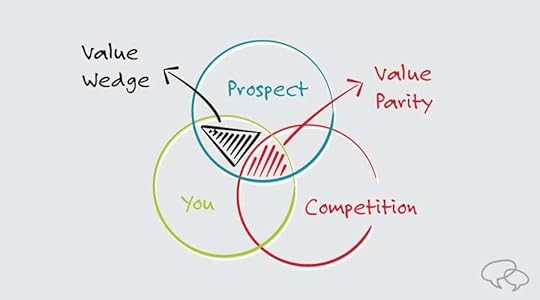
Instead of talking about what you do and why you think you can do it better, create a buying vision that defines a new set of challenges which align to your distinct strengths. This powerful value proposition will uncover previously unconsidered needs for your prospect, create contrast, and drive the urgency to change using stories and insights.
2. Create the Urgency to Change
Most companies unknowingly position
themselves for a competitive bake-off of features and benefits. They answer the
“why should I choose you?” question for their prospects. But in doing so, they
miss a critical first step.
The truth is that the majority
of buyers prefer to do nothing instead of change. In fact, 60 percent of
deals in the pipeline are lost to “no decision” rather than to competitors.
Staying the same is safe and comfortable, while change is associated with threat and risk. To break through Status Quo Bias and get prospects to leave their current situation, you need to tell a story that makes a compelling case for why they should change, and why they should change now.
Successful sales strategy requires you to understand your real competitor—the status quo. Help your prospects make the decision to change before you help them make the decision to choose you. Answering these questions are what creates your unique value, differentiates your solution, and sets the tone for your buyer’s entire Deciding Journey.
3. Tell a Compelling and Memorable Story
When salespeople prepare for
conversations with prospects, they usually focus on getting all the facts
straight about their offerings. But the most accurate information in the world
won’t resonate if you can’t connect with your customers in a memorable way.
Telling personal stories and using metaphors and analogies helps bring your message alive in a more compelling way than simply reciting facts and data. Storytelling paints a vivid picture for your buyers, illustrating the contrast between their current situation versus what’s possible, and connecting what you offer directly to their unique situation.
Once you start sharing stories
in your sales conversations, your customer relationships will become deeper and
more rewarding.
4. Speak to the Deciding Journey, Not Your Sales Process
A sales process is a set of
repeatable steps that a salesperson uses to lead a prospect to purchase.
Typically, the sales process involves several steps like prospecting,
qualifying, discovering needs, negotiating, and closing. This would be an ideal
checklist to follow if all your buyers were robots being taken through an
assembly line. But that’s just not the reality.
Marketing and selling today isn’t a predictable progression that you’ve decided is how your prospects and customers should buy. What you’re really up against today is a Customer Deciding Journey—a series of key questions your buyers are asking as they look to address specific business goals.
[image error]
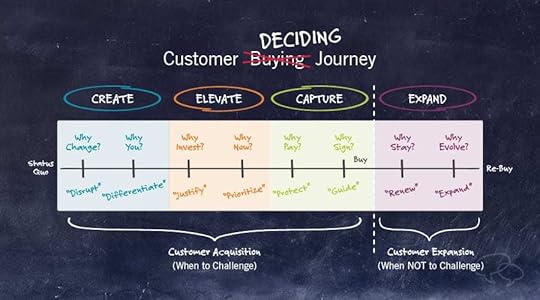
Instead of being
“program-centric” with a one-size-fits-all sales strategy, you need to be
problem-centric, addressing the specific needs of your buyers as they arise
with situationally relevant messages, content, and the skills to deliver them.
5. Don’t Rely on Buyer Personas in Your Sales Strategy
Customer profiles and buyer personas sound good in theory. The idea is to collect common demographic attributes, attitudes, and behaviors of your target audience to help frame and target your messages. But when used as a superficial profiling approach, personas can lead your messaging astray.
Persona-based selling assumes
that the behaviors or actions of your target buyer are motivated by their
internal characteristics. In reality, buyers are motivated by outside
influences that challenge their status quo and convince them to change. These
outside influences might include rapid growth within the company, inefficient
or unsustainable processes, or broader changes that affect their industry as a
whole.
The real drivers behind
behaviors and behavior change are the challenges within your buyer’s situation,
not their professional disposition. So, instead of focusing your
sales strategy on a lot of inconsequential attributes, speak to your buyer’s
situation and why their current approach is putting their business at risk.
6. Avoid the “Commodity Trap” in Your Sales Strategy
Too often, salespeople base
their messaging on the needs that prospects tell them they have. Then, they
connect those identified needs to corresponding capabilities, in standard
“solution selling” fashion.
The problem with this approach?
You fall into the trap of commodity messaging along with your competitors, who
are likely constructing their value message in response to the same set of
inputs. As a result, you sound just like everyone else, leaving your prospects
indecisive and without any real urgency to change.
Instead, you need to introduce Unconsidered
Needs that extend beyond the identified, known needs and solve for those.
Introduce prospects to problems or missed opportunities they’ve
underappreciated or don’t even know about. Then, connect the Unconsidered Needs
you’ve identified to your differentiated strengths, which are uniquely suited
to resolve those risks.
Research conducted by Corporate Visions found that a provocative messaging approach that begins by introducing an Unconsidered Need enhances your persuasive impact by 10 percent.
7. Lead with Insights, Not Discovery Questions
Many salespeople try to be a “trusted
advisor”—asking their buyers discovery questions, diagnosing the customer’s
needs, and then presenting a solution that fits the criteria. But this approach
does you and your customer a disservice.
To be of real value to your
buyers, it’s not enough to say, “Tell me what you want; I’ll get it for you.”
Buyers want salespeople who will tell them what they should want. They want you
to sift through all the information that’s out there and deliver insight into
what they’re missing that will improve their performance.
This means more than just
finding data and statistics online. A fact without a story is just a data
point. To make it real for your buyer, wrap your insights in a story that
connects the dots for them and provides context within their world.
8. Align Sales and Marketing
Too often, sales and marketing are siloed departments, each with individual goals that appear compatible. Marketing creates sales messaging and tools and generates leads for the sales team. Sales teams use the messaging and tools to transform those leads into revenue. But a lack of alignment and gaps in your process can sabotage your efforts.
You might hear the following
complaint from both sides: “We’re doing our job, but they just don’t get it.”
The problem with these goals is that they foster an us-versus-them attitude and
miss the big picture. Sales is a design point for better marketing. If Sales is
the storyteller of your organization, then Marketing is the story builder.
Ultimately, these two teams share—and must be aligned to achieve—one purpose: to persuade buyers to choose you.
Get our State of the Conversation Report, The B2B Content Disconnect, to learn how to drive action and conversions with insights-driven content, before and after a sales rep enters the picture.
9. Tailor Your Sales Strategy for Customer Expansion
Most sales and marketing teams
spend the majority of their budgets and effort on customer acquisition and
demand generation. Meanwhile, the majority of your annual revenue likely comes
from your existing customers, through renewals and upsells.
Nearly half of the companies surveyed by Corporate Visions invest less than 10 percent of their marketing budgets in customer retention and expansion. Clearly, your customers are highly underrated yet powerful growth engines within your company. And you shouldn’t overlook the potential of this untapped revenue stream.
The challenge is, retention and
expansion require a distinct messaging and customer conversation approach.
Existing customers are in a different position than your prospects—one that
carries a unique buying psychology.
While customer acquisition is all about challenging the status quo to highlight the benefits of switching to your solution, customer retention and expansion requires you to reinforce your position as their status quo. In fact, research shows that using a provocative, challenging message when you’re trying to renew or expand business with your customers will increase the likelihood that they’ll shop around by at least 10-16 percent.
[image error]

Check out our e-book, To Challenge or Not to Challenge, to discover research-backed insights into when you should (and shouldn’t) challenge your buyer’s status quo.
10. Enable Ongoing Situational Training
Most training and learning
efforts are based on a collection of competencies, supported by a curriculum
and catalog that gets scheduled on calendar-based interest and availability.
But what does that have to do with helping the company’s business strategy,
responding to shifting market demands and intervening to fix emergent needs
when they arise?
To be as effective and efficient as you need to be today, your sales training has to rise to a new level of flexibility, customization, and situational relevance. Using a flexible, on-demand training model enables you to deploy it at a moment’s notice to solve problems as they occur, and tackle initiatives as they arise. Training your sales team for situational agility equips them with the messaging and skills they need relative to the customer conversations they’re having.
Take Your Sales Strategy Beyond “Best Practices”
Most of the so-called “best
practices” out there won’t help your sales team succeed. Instead of following a
fill-in-the-blanks template, create a strategy that communicates more value in
your sales conversations.
Only with Corporate Visions
will you learn tested and proven customer conversation approaches for enabling
buyers to choose you at every stage of the customer lifecycle. That’s why the best
global B2B sales organizations come to us when they want skills training and
messaging solutions that are backed by rigorous research and proven to improve
results.
Get our sales e-book, Winning the Four Value Conversations, to get more research-backed sales messaging and skills for building a sales strategy that actually works.
Thank you for reading this post from Corporate Visions - Differentiate Your Marketing Messages and Sales Conversations.
November 14, 2019
6 Themes to Make Your 2020 Sales Kickoff the Best Yet
The post 6 Themes to Make Your 2020 Sales Kickoff the Best Yet by Eric Nitschke appeared first on Corporate Visions.
[image error]

Use these sales kickoff themes in 2020 to maximize profitability throughout the entire customer relationship, not just during the initial deal.
Filling the funnel, driving pipeline, and acquiring new customers will always be the exciting, swashbuckling side of B2B sales.
Similarly, when it comes to maximizing profitability, a lot of sales kickoff themes focus only on driving profitability from customer acquisition, ignoring all the opportunities for reps to drive profitable growth from renewals and upsells.
For your 2020 sales kickoff, think deeper. Prepare your reps to capture value on both the acquisition and expansion sides of the customer lifecycle.
Here are six research-backed sales kickoff meeting themes to
help your salespeople learn, remember, and actually apply their newfound skills
in 2020 and beyond.
6 of the Best Sales Kickoff Themes for 2020
1. Building Your Buying Vision
Too many kickoffs get bogged down by product knowledge breakouts (information) and fail to deliver the very thing the event was supposed to drive (behavior change).
But an overreliance on product presentations often come at the expense of more customer-centric activities, like practice and coaching, that drive more energy and better performance out of the gates.
Instead of presenting hours of feature-dense presentations that focus all on your solution, what if you modeled great customer conversations?
According to Forrester research, 76 percent of executive buyers will give their business to a company that illustrates a buying vision, compared to vendors among a group of commodity suppliers.
You don’t need to walk through every nuance of the new features they need to sell. Instead, teach your sales reps the conversation skills they need to create a compelling vision for your customers. Equip your reps with the skills they need to create the urgency to change from the buyer’s status quo.
Then, you can position your value in a unique and impactful way that persuades your buyers to choose you.
2. Refocusing Your Sales Process
Many companies stare myopically at each stage of their sales process to track pipeline, gauge opportunities, and forecast sales.
As a result, their own internal process is the focus of attention, and customer conversations are reduced to simply checking off boxes for each step of the sale. Ultimately, this practice takes away the most important part of any sales opportunity: the customer’s decision-making process.
71% of sales managers agree that the ability to articulate value is the biggest difference between high and low sales performers. So, what if you enabled your team to progress opportunities based on the conversations that customers truly find valuable? What if your reps could create pipeline based on differentiation, write proposals that pass executive muster, and close opportunities profitably without losing value throughout the sale cycle?
Instead of clinging to a self-serving sales process, train your sellers on the Customer Deciding Journey—a series of key questions your buyers are asking as they look to address specific business goals.
Then, you can help your reps build skills to address those
moments with situationally relevant stories and skills.
[image error]

3. Promoting Science-Backed Sales Techniques
CEOs and other leaders are often lured by shiny new trends within the market. They then try and incorporate those trends into sales training. The challenge is that these so-called “best practices” are based on other peoples’ successes, and you won’t find long-term success by imitating other people.
Your competitors read the same books, and even if they work
for a short time, those shiny new approaches quickly become dull and commoditized.
At best, you’re frustrating your team. And at worst, your enabling mediocrity.
What if you didn’t follow the crowd to your book club’s favorite theory, and instead introduced skills that leverage how the human brain perceives value, and how buyers make decisions based on human psychology?
Equip your team with selling techniques that are proven to work, instead of what’s most popular in the moment. Understanding how customers buy versus how other salespeople sell will make a much greater impact at your sales kickoff, and beyond.
4. Telling the Right Renewal Story
If last year’s sales kickoff was all about training your salespeople to challenge and provoke your buyers, you were really only preparing them to acquire new customers.
As for keeping your current customers? Not so much.
Corporate Visions research shows that using a provocative, challenging message with existing customers—when you’re trying to renew or expand business with them—will actually backfire. In fact, you’re increasing your risk of losing them to your competitors by at least 10-16 percent.
Despite this glaring evidence, however, nearly 60 percent of companies don’t feel the need to tell a different story for customer acquisition versus customer retention/expansion.
That’s not good for your growth plans. According to Harvard Business Review, acquiring a new customer is anywhere between five to 25 times more expensive than keeping an existing one. That’s not too surprising when you consider the high cost of acquisition. You might need to keep a customer account active for months, maybe years, before they become fully profitable.
Given these findings from our research, the renewal story isn’t something companies should just leave to chance. Nor is it a message that should in any way resemble the story you tell to acquire new customers.
5. Communicating Price Increases Effectively
Renewals aren’t a conversation you want to take lightly, and the same goes for price increases. Communicating a price increase is one of the trickiest, most delicate conversations you’ll have with your customers. But for companies with aggressive growth goals, it’s also one of the most essential.
Unfortunately, many companies skimp on the messaging rigor in this vital conversation. A Corporate Visions industry survey found that four out of five say they want more direction and guidance around communicating price increases.
Like the renewals, your price increase discussions demand the kind of messaging that’s fundamentally different—even opposite—from the story you tell when prospecting. As a result, salespeople need to be trained to understand the unique buyer psychology, and how to address it, in this critical sales opportunity.
6. Persuading Customers to Expand with You
87 percent of companies say the upsell conversation is important or very important to revenue success and retention, according to our research. But, nearly 60 percent say they’re only somewhat satisfied or worse at converting customers to higher value solutions.
There’s a lot hanging in the balance in the upsell dialogue.
Succeed, and you lay the groundwork for better customer experiences and
longer-lasting partnerships. Stumble, and your partnerships stagnate, your
revenues level off, and you could become vulnerable to getting picked off by
competitors, who can disrupt you out of the equation with promises of something
better.
To prepare your reps for this sales conversation, they need
to understand how to reinforce the emotional aspects of the customer partnership.
This helps make change seem safe to your customers—as long as they’re changing with
you, not away from you.
Get Specific with Your Sales Kickoff Themes
Sales kickoffs with generic training and product certification sessions aren’t going to help your reps get better results. Product knowledge doesn’t address the wide range of selling moments they need to master. And as a result, they won’t hit their numbers next year.
To get the most out of your kickoff, hammer out your products, marketing and sales strategy for the year ahead, identifying what types of situations your reps will face. Then align your sales kickoff themes accordingly.
Looking for more tips to building a successful sales kickoff? Check out our e-books, Why Your Sales Kickoff Needs a Shake-Up and Putting Your Sales Kick-off In Context.
Thank you for reading this post from Corporate Visions - Differentiate Your Marketing Messages and Sales Conversations.
November 7, 2019
Are Buyer Personas Sabotaging Your Sales?
The post Are Buyer Personas Sabotaging Your Sales? by Tim Riesterer appeared first on Corporate Visions.
[image error]

One of the most popular “best practices” in B2B sales and marketing is to create buyer personas.
These fictional characters usually have names, and they embody all the traits of your ideal prospects. Typical buyer personas include a character sheet full of your prospects’ demographics, challenges, goals, and KPIs. The idea is that if you understand your buyer’s specific position within their organization, you can better focus your message to resonate with them.
But for all the good intentions behind them, the typical
model for buyer personas might actually be sabotaging your efforts. Here’s why.
Over the last decade, the B2B buying process has only become more complex. In 2015, an average of 5.4 people needed to formally sign off on each purchasing decision. Because of this, salespeople are commonly pressured to get familiar with the personas of several different decision-makers, and tailor multiple messages to each person’s specific needs.
While this seems like a reasonable and responsible premise
at first blush, you can see how crafting, learning, and delivering customized
conversations to nearly six different people with varying roles and
responsibilities quickly becomes unmanageable.
And it gets worse.
Today, Gartner reports that “the typical buying group for a complex B2B solution involves six to 10 decision makers, each armed with four or five pieces of information they’ve gathered independently and must deconflict with the group.”
In other words, there are more decision makers involved in the buying committee than ever before, and they’re all being targeted with highly personalized messages. Because of this, buyers are suffering from what Gartner calls a “crisis of confidence.” They’re feeling overwhelmed with high-quality information from vendors. And it’s causing deals to stall or shrink in size and scope.
So, what can you do?
First, you need to understand that prospects won’t change their status quo because of who they are, their demographics, or their job characteristics. Rather, prospects react more powerfully to whether or not their current situation is putting them at risk, and whether they’re convinced that they must do something different to preserve their best interest.
Fundamental Attribution Error
The decision-making science that backs this up is called
“Fundamental Attribution Error.” This means that humans naturally tend to
overestimate the effect of a person’s disposition on their behaviors and
underestimate the impact of their situation.
For example, when you’re driving on the highway and someone cuts you off, your immediate reaction is to assume that the person is a jerk. You’re more likely to attribute that driver’s behavior to their personality, or disposition. But it’s more likely that the driver’s situation is to blame for their erratic driving behavior.
They might be late for work, and this could be the last straw with their boss. They might have a medical emergency. Or they might just desperately need to find a restroom. It could be any number of situations that’s motivating their behavior, rather than their inherent disposition.
The same can be said about basing your sales and marketing messages on personas. You can put all your time into tailoring your messages to each individual’s disposition—their title, responsibilities, and KPIs. Yet this information won’t motivate them to change and do something different.
Buyer Personas Don’t Create Urgency to Change
Most of the information in buyer personas has very little to do with whether there’s actually an opportunity to create a sale.
For example: You’re responsible for selling marketing automation software to help manage a company’s marketing campaigns, social media presence, and demand generation efforts. You build personas for each of the buying influencers in the deal. Starting with the marketing executive, you identify their key performance indicators, such as:
Increasing lead generation volumeExpanding marketing-sourced contributions to
pipelineImproving quality and conversion of leads to
close businessEnsuring ROI of marketing investments
However, according to the concept of Fundamental Attribution Error, urgency to change exists in the buyer’s context, not in their character.
If you build and tell a story based on the KPI of improving lead conversion to closed business, you might spark your prospects’ interest level, but the real connection point—the urgency to change their status quo—is created when you show them how their current approach (situation) is putting them at risk relative to their desired outcomes.
Our recent research on executive-level selling backs this up. In the study, executives were far less likely to take a sales meeting when approached with a known business initiative, compared to a disruptive sales message that de-stabilized their current approach.
A Better Approach to B2B Buyer Personas
It’s only in connecting to the gaps or flaws in the prospect’s current approach that you provoke opportunities and the urgency required to build a buying vision.
To ensure your messages hit the mark, we recommend using a “Status
Quo Profile” as the starting point. Clearly define your prospect’s status quo, learn
it inside and out, and use this knowledge to create effective messaging that
moves your prospect to make a change.
To build a more effective buyer persona for your sales messaging,
answer the following four questions:
1. How are prospects addressing the challenges your product or service can
solve today?
Even before they come across your company and solution, your
prospects think they are already doing something to solve their problems and
meet their business needs. So, to change their perception, you need a precise
understanding of what your potential customers are currently doing to solve
their problems.
Your messaging will have to take aim at dislodging an
incumbent, so knowing your opponent is essential.
2. Why do prospects think their current product or service is great?
Remember, prospects live in their story—not yours. Prospects
were doing something a certain way before they chose the way they’re doing it
today, and they assume they already have a better solution than the one they
had before. Therefore, chances are that you’re sending messages to people who don’t
even think they have a problem. Or, at least, they still remember the benefits
they based their last decision on, and assume they’re still getting that same
value.
3. What issues, challenges, threats, risks, or missed opportunities have
surfaced since prospects purchased their current solution or implemented their
current approach?
Remember, not everyone is a prospect for your solution. Your
real prospects are those buyers who have a certain “installed”
approach that can cause limitations because of a changing business environment.
You need to focus on the ripest opportunities for change, so
document the things that are changing in your prospect’s industry, including
changes in environment, competitive space, the global marketplace, or anything
that the current approach may not have taken into account, or is ill-equipped
to handle.
4. What oversights in your prospects’ current approach will keep them from
avoiding potential problems or capitalizing on new opportunities?
When you present challenges to prospects, they’ll first
react by seeing whether their current approach or solution can be
“stretched” to overcome the challenges you identify. Therefore, you
will have to identify and amplify clear omissions in their current approach
that will prohibit them from resolving those obstacles. Those gaps need to lead
to your unique strengths or capabilities.
Creating gaps that are too wide to cross with your
prospect’s current solution—their status quo—is essential for crafting messages
that will compel your prospects to change.
Speak to Your Buyer’s Situation, Not Their Disposition
The real drivers behind behaviors and behavior change are the challenges within your buyer’s situation, not their professional disposition.
You don’t need to focus your sales messaging on your prospect’s title, position, or persona. Instead, speak to your prospect’s situation. Help your buyers realize that their current approach is so limiting that it puts their strategic objectives and/or their desired outcomes at risk.
Want more tips like this to improve your sales skills? Read our collection of research-backed selling techniques.
Thank you for reading this post from Corporate Visions - Differentiate Your Marketing Messages and Sales Conversations.
October 31, 2019
Executive-Level Selling: How to Actually Gain Access to the C-Suite
The post Executive-Level Selling: How to Actually Gain Access to the C-Suite by Tim Riesterer appeared first on Corporate Visions.
[image error]

The most popular approach to executive-level selling is the least effective, according to new academic research from Corporate Visions.
Conventional wisdom about executive selling says that if you
want to talk with an executive, you need to talk like an
executive. You need to offer up relevant case studies, ROI calculations, and
quantified strategic results as the price of entry.
But that advice is over two decades old—popularized at a time when you had limited access to executive decision-makers and almost always had to finesse your way around the gatekeeper.
Sellers today have multiple, more direct paths to C-suite
selling, yet getting through that boardroom door is harder than ever. And if
your sales message doesn’t resonate with that busy executive, they’ll brush it
aside without a second thought.
So, what messaging approach works best for executive-level
selling? That’s what we set out to learn in our latest research study.
The Research: Gaining Access to Executive Buyers
To test the best sales approach to reach senior executives,
we partnered with Dr. Nick Lee, Professor of Marketing at Warwick Business
School, to look at the best executive selling approach a sales rep can use to
get access to an executive and secure time on their calendar.
In this simulation-based test scenario, we recruited over
400 C-level executives with VP or higher titles in companies larger than $50
million, across multiple industries, who had authority over budget and
purchasing decisions.
The executives were told they were reading an email from an
outside vendor sales rep they didn’t know and had never met with before. They
were then randomly divided among four test messaging conditions. After reading
the message, they answered a series of questions, including whether they would
take a meeting, decline, or delegate.
The Four Sales Message Test Conditions
These four test messages represent a “best of breed” example
for executive selling. They’ve all been recommended and used with noted success
in various messaging environments for 20 years or more.
Unique Product Value Proposition: This approach uses a proven model for creating and delivering a differentiated product value proposition that shows how the seller’s solution helps solve a problem in a new, different, or better way than competitive alternatives.Known Business Initiative + ROI: This is a popular approach that’s been widely promoted for the last 20 years across a variety of sales processes and skills training programs. It’s where the seller demonstrates they’ve done their homework and understands the priorities or challenges that the executive is trying to address. Then, they share quantified ROI results from other similar customers and offers an estimated potential impact on the executive’s business. Provocative Industry Insight: This approach introduces a new need the executive hasn’t considered up to this point, based on the seller’s experience with other customers. This “Unconsidered Need” may be a problem or missed opportunity the executive doesn’t know they have or doesn’t fully appreciate. This is an approach we’ve tested and proven to work in other sales conversations but had not yet tested specifically as an approach to gaining executive access. Competitive Benchmark Offer: This approach has generated a lot of buzz recently. The seller offers to benchmark information comparing the prospective executive’s company to other similar companies. Ideally, it includes exclusive data your company developed with existing customers in relevant industries. This data offers executives a chance to see how they stack up across a range of key performance indicators.
Research into Executive-Level Selling Reveals a Clear Loser
The results of this study reveal a clear loser. The “Known Business Initiative + ROI” condition—the “VITO”-style approach promoted by so many sales processes and skills training companies for the last 20+ years—consistently finished last across the board.
In fact, the executives in the Known Business Initiative + ROI test condition:
viewed the vendor as nine percent less
credible than did the participants in the other test conditions were nine-and-a-half percent less confident in
the vendor than were the participants in the other test conditions were more than 10 percent less likely to take
the meeting than the participants in the other test conditions were 12 percent more likely to decline the
meeting than the participants in the best-performing messaging conditions
[image error]
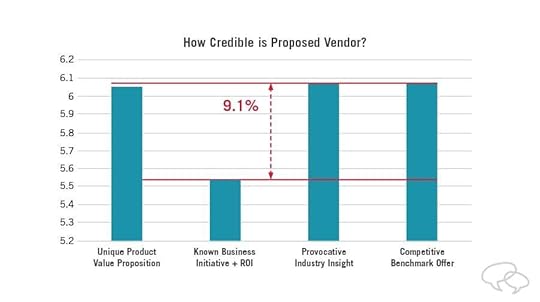
[image error]
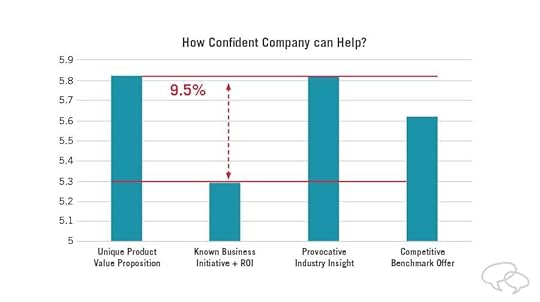
[image error]

[image error]
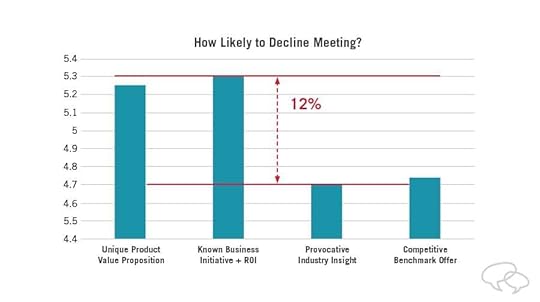
Why Was Conventional Wisdom Wrong?
Why was the Known Business Initiative + ROI approach—a message advocated by so many training programs for executive-level selling—perform so poorly?
If you’re trying to get an executive’s attention and get on their calendar, you need to overcome what decision scientists call Preference Stability (one of the four causes of Status Quo Bias).
How do you de-stabilize a preference? Not by simply telling the executive that you can do what they’re asking. That will only reinforce their preference. You destabilize preferences by offering new information that they don’t know. Offering that new information either changes how they define the problem or changes the range of options they have available to solve it.
A Known Business Initiative is, by definition, already known
to the executive, and offers no new information to de-stabilize preferences. So,
it appears that you can’t defeat your executive prospects’ existing preferences
with abstract speculation about ROI pertaining to a business need they’re
already aware of.
Based on the research results, you can also eliminate the Unique Value Proposition message. Notice in the charts above those executives in the Unique Value Proposition test condition were equally willing to either accept or decline a meeting. Because the results aren’t consistent or reliable, we don’t recommend using it.
What’s the Best Approach for Executive-Level Selling?
Which approach is best for executive-level sales conversations? Prior research from Corporate Visions has the answer.
An earlier study, conducted with a nearly identical executive panel as this research, examined the messaging approach that persuaded executives to move forward with a proposal in a meeting. In that study, a message that introduced a provocative, Unconsidered Need was consistently the most effective approach.
We call this the Why Now Story Model. Here’s a breakdown of
each step in the Why Now message framework:
Present a business issue rooted in
external trends and factors the executive will identify with and connect back
to their strategic initiatives; Introduce Unconsidered Needs—that is,
unforeseen problems, challenges or missed opportunities your prospect has
underappreciated or doesn’t yet know about that create flaws or limitations in
his or her current approach; Provide a solution story, demonstrating
specifically how you can resolve the Unconsidered Needs you identified and
enable them to realize their goals; Quantify business impact by sharing a
preliminary calculation of how your solution can positively influence revenues,
cost savings, and operating margin.
The goal in your Why Now conversations are to generate enough curiosity that you elevate your value beyond what you’re selling, and into your conversation as a whole. If an executive perceives that you’ve delivered a valuable conversation, you’ll get them to take the desired next step toward a decision.
The Provocative Industry Insight message in this research is based on the Why Now approach.
Providing competitive benchmarking in your prospect’s
industry is interesting, it is very difficult for many companies to develop
meaningful data to make that a reality across various industries they serve.
Also, while it’s good at raising their curiosity, we have no research to prove
it is helpful in getting a deal across the line.
That’s where the Why Now message edges out the competition.
Research has already proven that introducing provocative industry insights is
an effective way to add urgency and value to your C-level conversations.
It’s a slightly different situation when you’re trying to convince an executive to take a meeting versus persuading them to buy now. But we believe that being consistent in how you get the meeting and then deliver the meeting is important for executive-level sales conversations.
For more details about this research and how online training works, download our State of the Conversation Report, The Key to the C-Suite: Messaging for Executive Access.
Thank you for reading this post from Corporate Visions - Differentiate Your Marketing Messages and Sales Conversations.
Timothy Riesterer's Blog
- Timothy Riesterer's profile
- 3 followers



